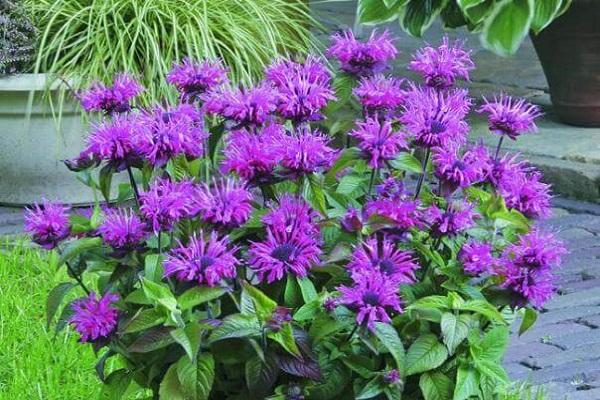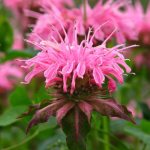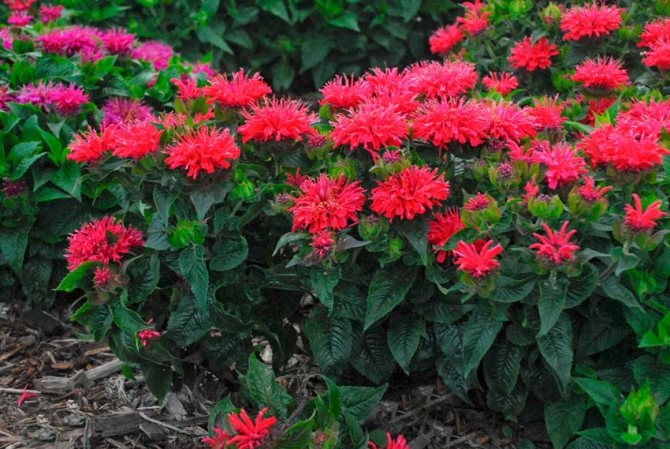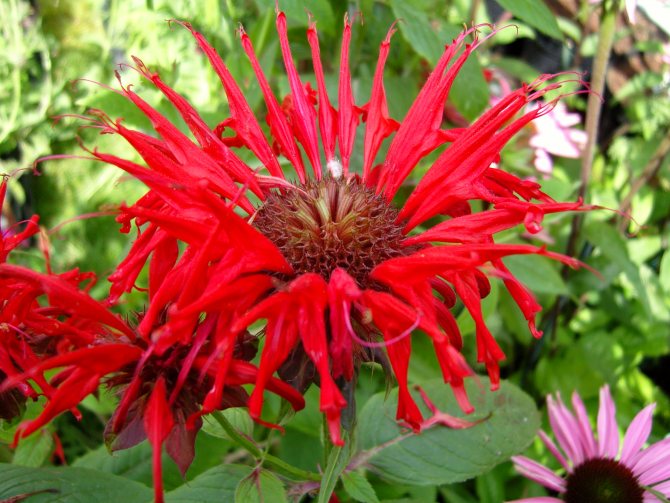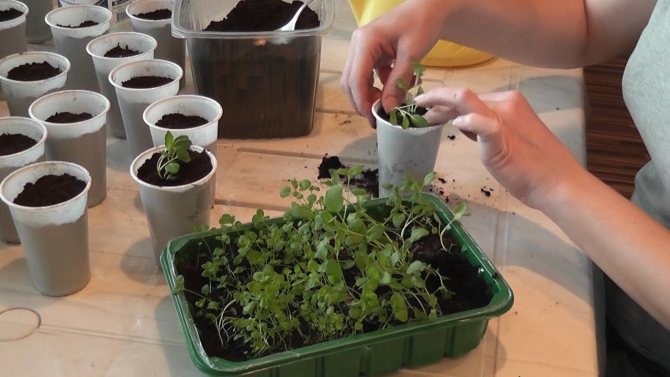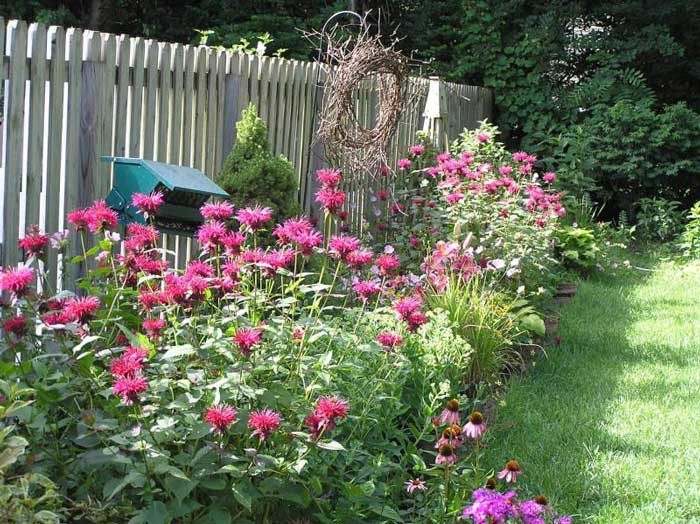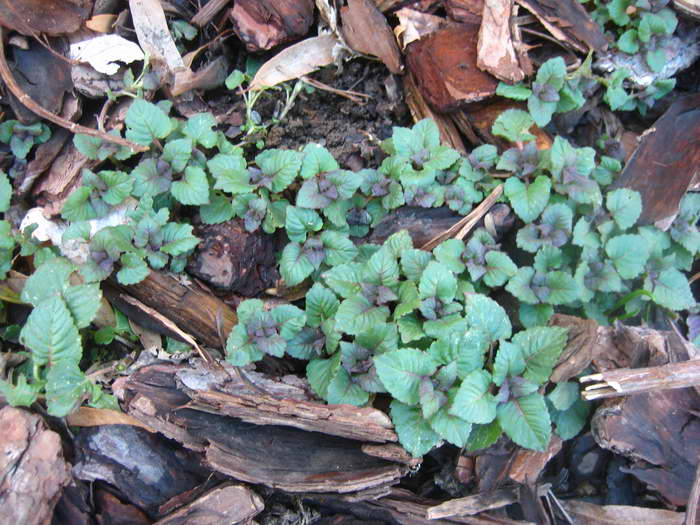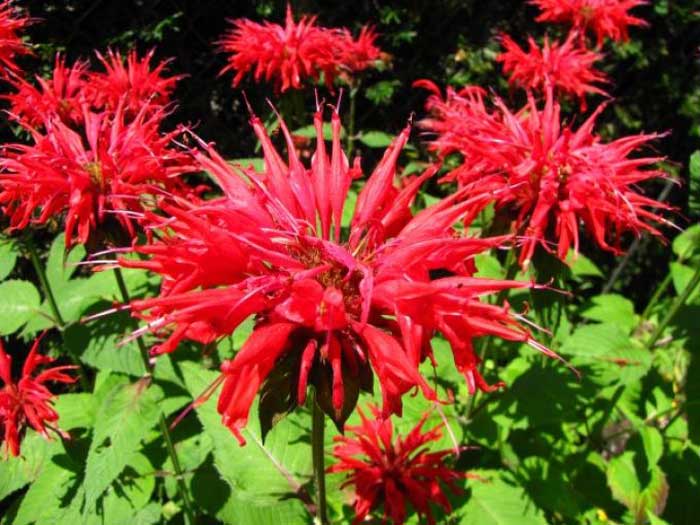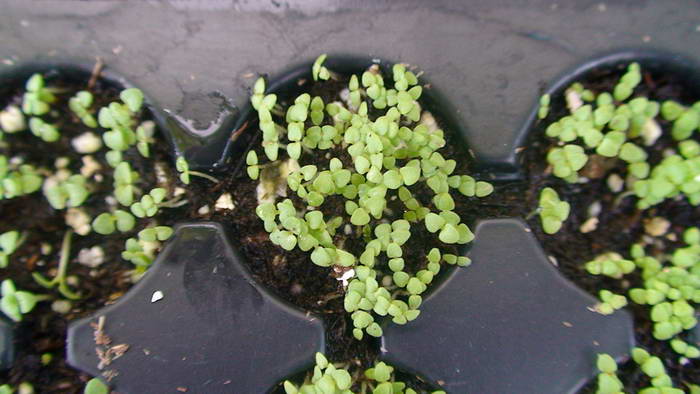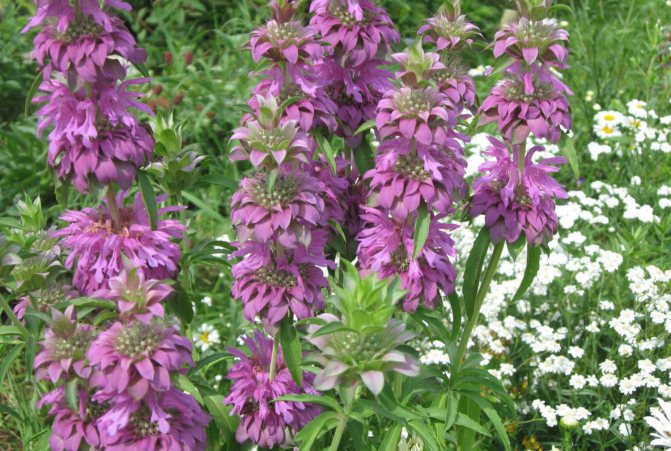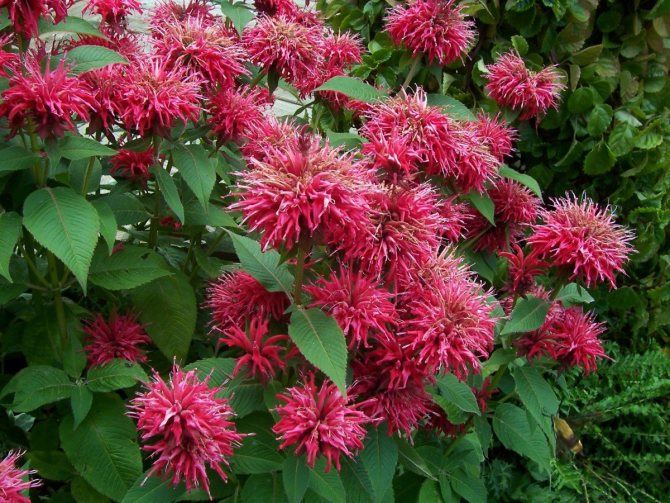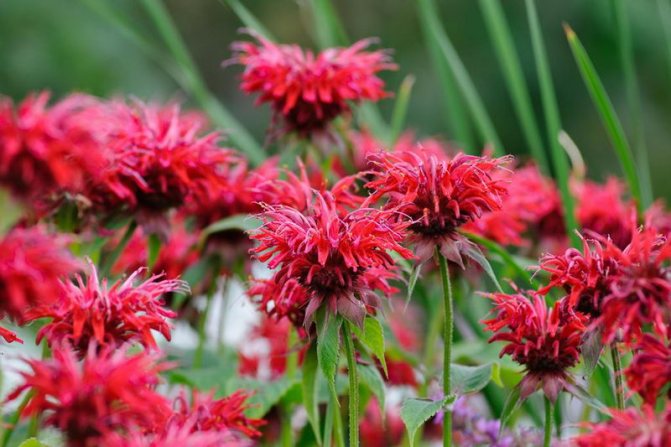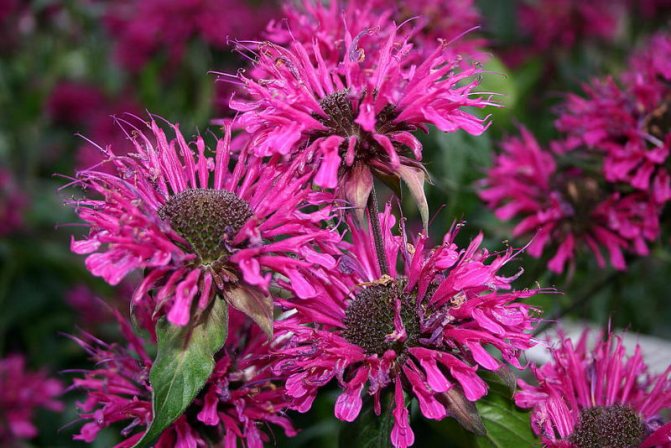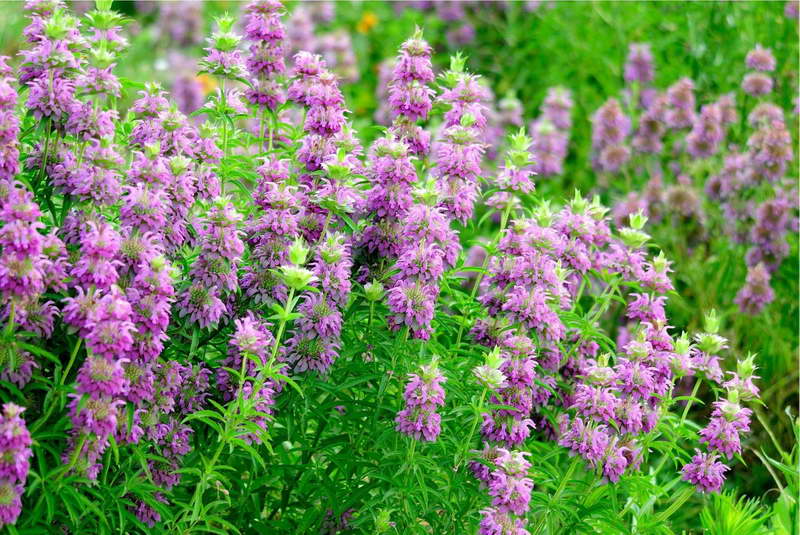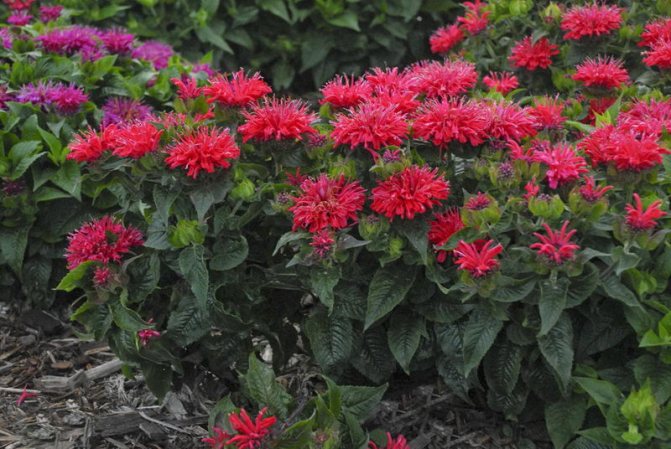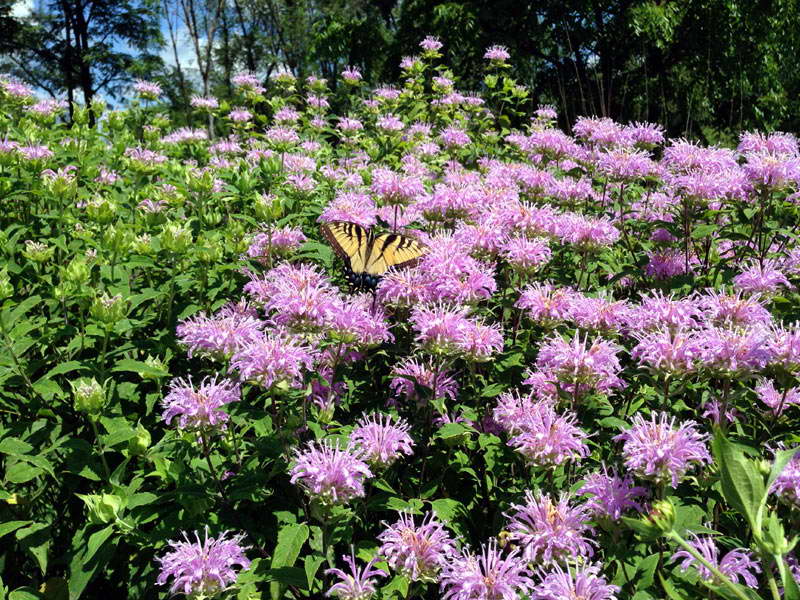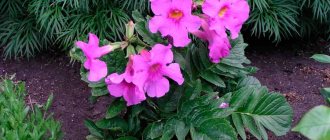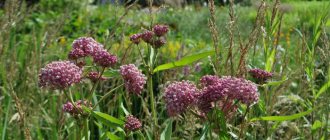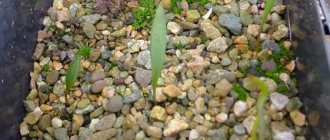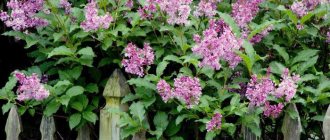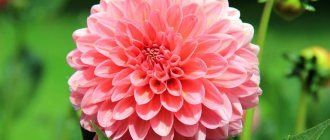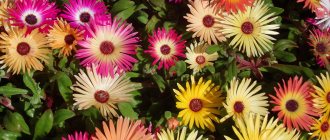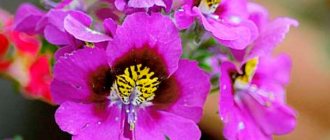Of the 20 species of the Lamb family of annual and perennial grasses, which originate from the North American continent and are widespread from Mexico to Canada, the Monarda plant is noteworthy. Carl Linnaeus, in the name of the flower, immortalized the name of the Spaniard Nicholas Monardes, who devoted his life to healing and botany, and in 1574 published a book about the plants of America.
In his book, Monardes mentioned another name for monarda: the plant was then known as the soulmate of Virginia or Canadian Origano. Once in the Old World, the monarda attracted attention primarily as an essential oil plant and from the 19th century it became better known as bergamot, American lemon balm or lemon mint.
Description of monarda
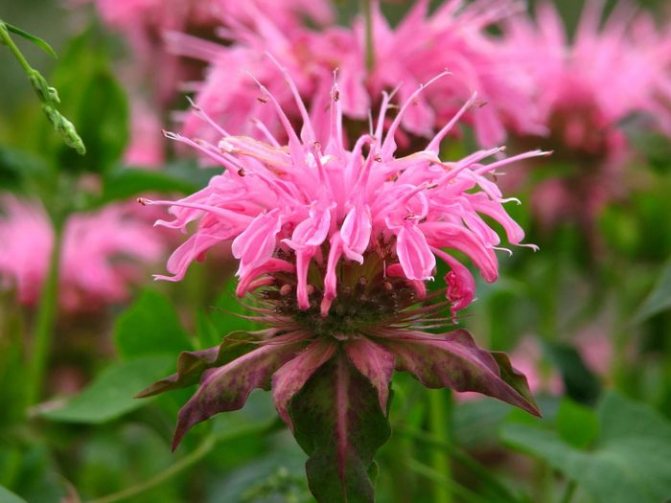
Monarda is a relatively tall rhizome plant. Usually its height reaches one and a half meters. Monarda leaves have a pleasant smell and an oblong shape. It is not difficult to recognize the monard by the pointed edges of its leaves. The flowers, collected in a neat brush, are small in size. Their diameter usually does not exceed 7 cm.
Monarda flowers of various colors are found in nature, the most common are white and red variants. Flowers grow over the entire surface of the stem, making this plant very beautiful. The seeds are located inside the monarda fruit, which appears to the gardener in the form of a small nut.
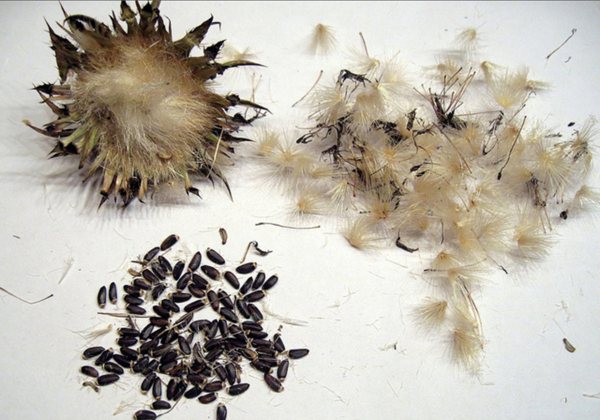

Monarda seeds
Monarda seeds have a high germination rate. They keep it for 3 years. Monarda does not require many sites for planting. The plant can be planted on the same plot of land for 7 years.
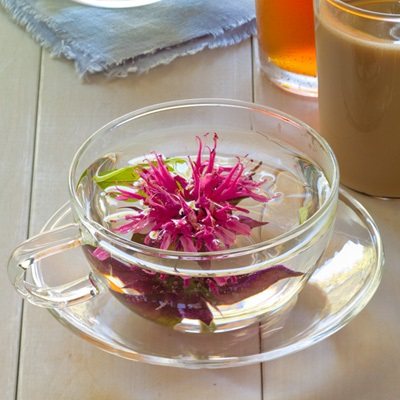

Monard tea
Gardeners love Monarda not only for its external advantages, but also for its pleasant floral scent. Moreover, this smell is suitable not only for ennobling the territory. In recent years, it has become fashionable to use monarda as a spice. Many connoisseurs even add it to tea and bring to life the planting of the monarda and caring for it exclusively for the sake of this.
Monarda in landscape design
The plant is perfect for growing in flower beds, ridges, lawns. When planting a perennial mixboder, the monarda is ideal for background decoration. Cereals perfectly complement the spreading bushes of monarda. In addition, next to the monarda are planted: rudbeckia, perennial phlox, bells, large chamomile.
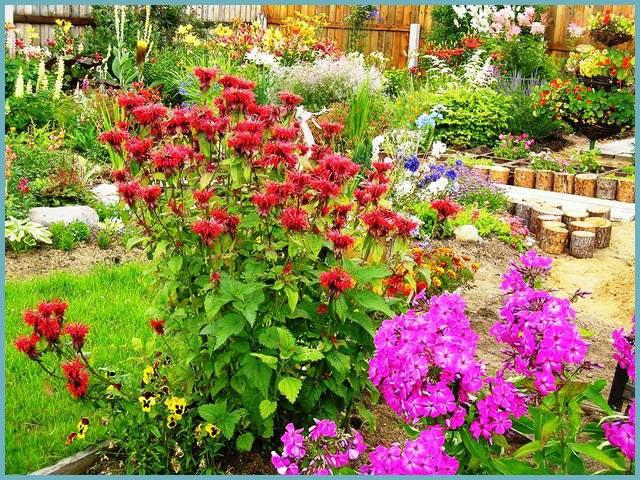

Monarda in landscape design
Separately planted monarda bushes decorate lawns and ridges. A tall plant is perfect for decorating fences and hedges.
Photos of various plantings of monarda suggest new options for using this worthy and resistant plant, emphasizing the decorativeness of the planting territory.
Planting monarda in spring
Leaving and planting monarda in open ground can be carried out before spring, when it comes to hot regions. This process does not require special training from gardeners. It is enough just to wait for a more or less warm February day and send the seeds to the ground.
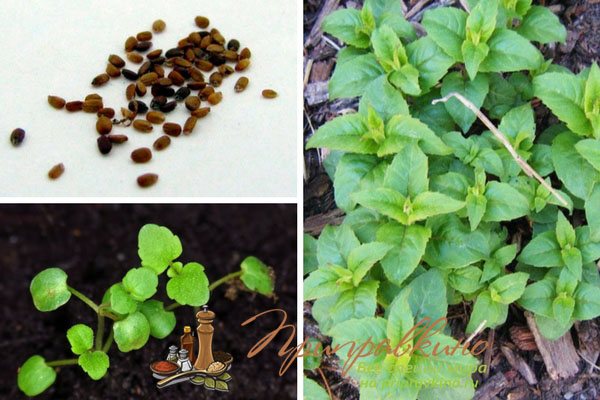

Seeds and shoots of monarda
Seed stratification will take place until April, and the cool spring climate typical of Russia will only speed up and facilitate it.And in April, the gardener will be able to enjoy the shoots that have appeared, which will be so thick that in a few weeks they will have to be thinned out.
You should not plant a monarda on a land plot that is covered with snow. The snow cover should be eliminated, and the earth should be warmed up, tightly covering it with cellophane film. The heated earth will then be much easier to loosen and mix with sand.
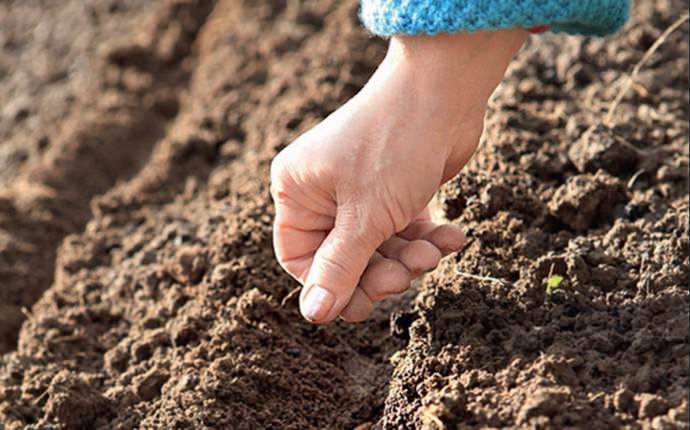

Sowing seeds
When the site is ready, all that remains is to sow the seeds. Monarda does not need a great depth: the seeds should be planted no deeper than 2-2.5 cm. For dusting the sown seeds, you can also use soil, but many experts note that ordinary sand is much better suited for this purpose.
Popular varieties
Gardeners identify several of the most popular varieties of monarda.
Mahogani
A perennial plant with a long root and a height of up to 150 cm. One of the largest flowers among all monard varieties with a thick and strong stem and small dark green leaves. The inflorescences have a raspberry-red hue and a pleasant lemon-mint aroma. The minimum diameter of one inflorescence is 7 cm. The flowering of monarda begins in July and pleases until the very frost.
Citrodera Harlequin
Compact, low monarda only 30-35 cm in height. The flowers are collected in an inflorescence called the sultan. Has a sophisticated bergamot aroma, presentable appearance. This variety is in great demand among gardeners.
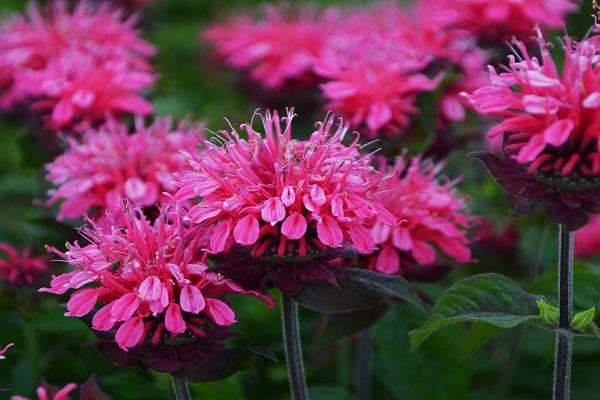

Panorama
Perennial culture with a delicate color of capitate inflorescences, crowning the tops of tetrahedral shoots. The height of the central stem can vary from 60-80 cm. The inflorescence reaches 6 cm in diameter. In autumn, the monarda complements the landscape with its attractive exotic fruits with nuts.
See also
Treatment of a spider mite attack on balsam at homeRead
Terry Tale
Winter-hardy perennial monarda with a varied color range of inflorescences, ranging from white to dark wine color. Due to the variety of shades, the culture was called the Terry Tale. Plant height from 60 to 80 cm. Flowers, collected in capitate inflorescences, are located at the tops of tetrahedral shoots.
Pink Lace
Low-growing monarda up to 40 cm in height and 45 cm in width. The flowers form large, lush inflorescences of a pink-crimson hue. The leaves are dark green and slightly rough. The plant is fragrant, unpretentious and frost-resistant.
Bergamo
The variety is presented in the form of a small bush with serrated leaves of a dark green color. The buds are terry, which is why, according to the observation of gardeners, they are similar to many-legged insects. It grows from the second decade of July to the very frosts. The greenery lasts until late autumn. Monarda foliage tastes like bergamot, so it is added to tea.
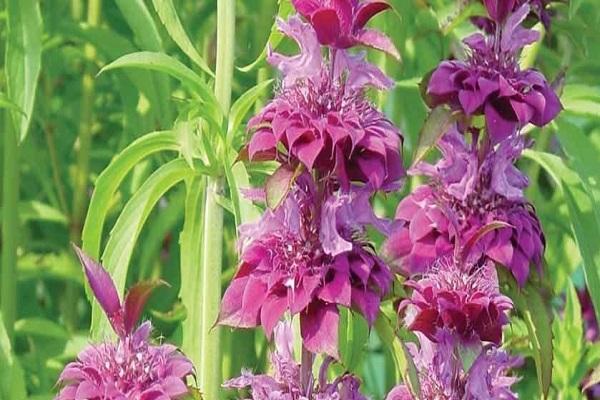

Suprem
A popular perennial variety due to its fragrant cut leaves and fragrant multi-colored flowers. Flowering lasts from July to September, develops well on any soil. Used to decorate local areas in group plantings.
Diana
Decorative monarda with a pleasant mint-lemon aroma, grows in bushes up to 45 cm in height. It has thin peduncles with 5-7 whorls of attractive flowers of various shades that look like a candelabrum. Able to bloom for a long time and abundantly, it is cold-resistant. The variety is recommended for group and single plantings.
Pink Lace (pink)
Low-growing monarda up to 40 cm in length and slightly more in width. It has pink flowers, collected in large and lush inflorescences at the top of the shoot. The name comes from the color of the inflorescences. The leaves are dark green in color and have a pleasant scent.
Mona lisa
Monarda grows in the wild in North America and Mexico.A fast-growing perennial herb, sometimes mistakenly referred to as bergamot due to its pleasant smell and botanical similarity to this plant. Monarda has thin twisting stems, on top of which are located white, pink or purple inflorescences.
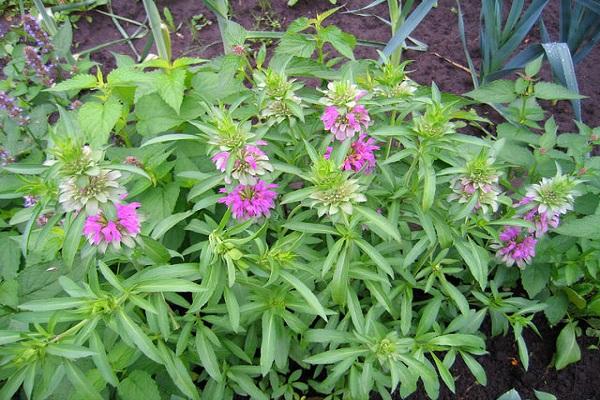

Cambridge scarlet (red)
A hybrid perennial plant with a long horizontal rhizome and erect stems on which trichomes are abundantly distributed. Stem height varies from 80-100 cm. Oval-shaped opposite leaves up to 12 cm long in a light green shade. Inflorescences 6 cm in diameter develop at the top of the shoot.
Cambridge scarlet
Perennial with an elongated horizontal stem. The height of the shrub is 80-100 cm. Pale green leaves opposite each other are located on the shoots.
Jacob Cline
The plant has large flowers of a bright red hue, and the bracts are dark purple. The flowering period occurs in the first decade of July - the last week of August. Fragrant leaves are used for brewing tea. The maximum shoot height is 120 cm.
Preirinacht
A perennial flower with a tetrahedral stem up to 100-140 cm high. Large purple flowers, collected in whorled inflorescences, the diameter of which varies from 6 to 8 cm. They bloom from early July to late August. The ground parts of the plant have a tart lemon-mint smell.
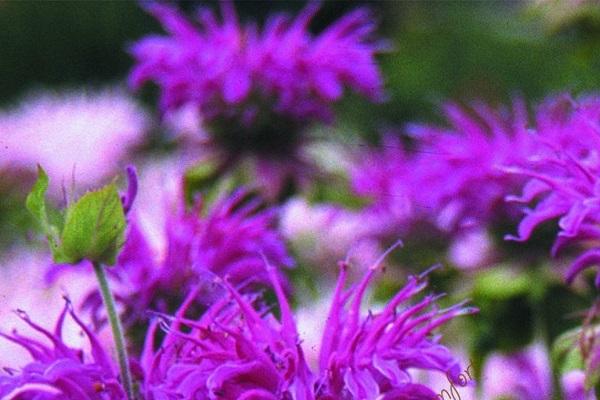

Dancing bird
The culture reaches a height of 1.5 meters, is distinguished by a long rhizome and straight branchy shoots. Leaves are oval in shape with a toothed edge. Small flowers, due to their abundance, form lush inflorescences.
Snow White (white)
The variety with snow-white flowers looks spectacular in single plantings and in combination with other plants. A small bush, compact. All ground parts of the flower have a pleasant characteristic aroma.
Sowing monarda in autumn
Leaving and planting monarda can be carried out not only in the spring. Many gardeners carry out this process before winter. If you have chosen this option, you should proceed to planting only after the season has finally ended and all the seeds have been collected.
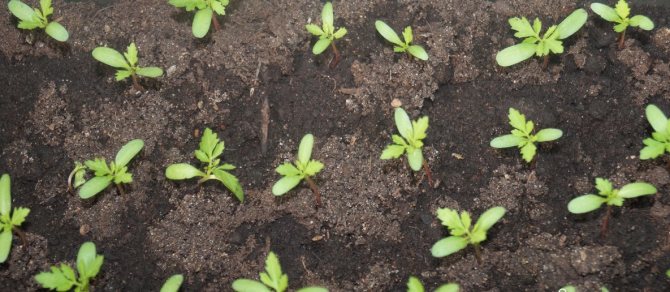

Shoots of monarda
For sowing monarda before winter, it is very important to take into account the climatic conditions of the region in which you live. For a successful process, it is required that a serious cold snap sets in: on one edge of Russia, it comes in early October, and on the other, it will have to wait until December. Warm weather is dangerous because the seeds can germinate ahead of time.
A seedbed should be prepared in advance, as the earth takes time to settle. It is worth keeping a distance of at least 0.25 meters between the furrows. Seeds are sown no deeper than 2.5 cm.
By the beginning of spring, the formed seedlings must be dived. This will provide the garden with beautiful and hardy shrubs. Experts advise to show more patience, as the monarda rises very slowly.
Preparing for winter
The annual monard is simply disposed of. Summer residents usually leave her in the flower beds until the first snow so that the birds can feast on her seeds.
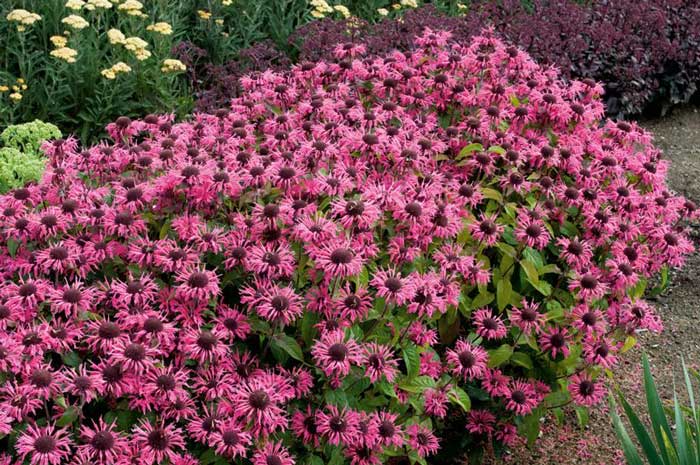

Perennial plants are quite resistant to low temperatures; withstand up to -25. But if winters are harsh in the region, then additional insulation of flower beds will not hurt. Practical technologies for covering vegetation under winter cover are described in detail here.
On a note! Monarda has a variety of colors. Indeed, in addition to varietal species, there are many hybrids of this plant. Therefore, the beauty of the blossoming buds should not be the determining factor. When choosing a monarda, you need to pay attention to how much it is adapted to a specific region. Then there will be no problems with growing it on the site.
Have a beautiful garden!
Planting monarda and caring for it at home
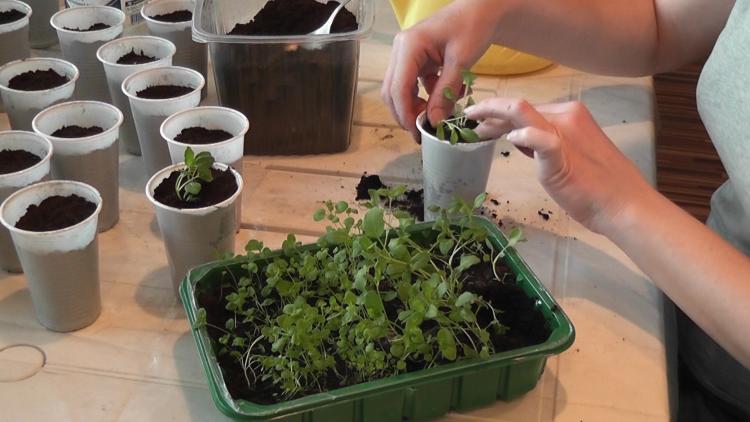

Monarda seedlings dive
Monarda, planting and caring for which requires a lot of effort from the gardener, can also be grown at home. Moreover, among Russians engaged in planting monarda, this method is the most popular.
In order for everything to work out, a number of conditions must be met:
- Seedlings are sown already in the middle of winter so that in April they are ready to be transferred to open ground. For planting it, ordinary wooden boxes are suitable, filled with drainage and soil suitable specifically for flowering plants;
- The embedding of seeds should be at the level of 2 cm;
- It is important to keep the temperature at least 20 degrees. For this, the box can be covered with plastic wrap or plastic bags.
At home, monarda matures much faster. In less than a month, the long-awaited shoots will appear, and after another 3 weeks full leaves will already ripen on them. After that, you need to unpack the monarda as soon as possible into separate glasses or more capacious containers.
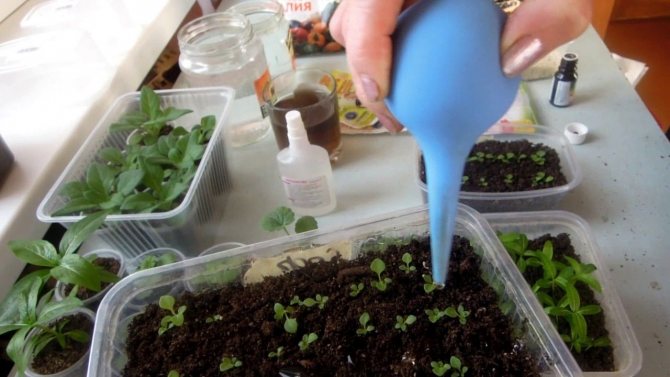

Watering seedlings
Monarda does not really like moisture, so you need to water it carefully so as not to harm the plant. Due to the abundance of moisture, rot may appear on its stem or leaves. But light is a necessary condition for the growth of a monarda, it is very important that the plant always stands in a well-lit place.
It is better to avoid high temperatures, it is worth maintaining the climate at 20 ºC, otherwise the monard will be unnecessarily stretched. If, nevertheless, this happened, you need to add earth to the glass with the monard - this will help to avoid deformation of the seedlings.
As new leaves appear, the monard must be hardened. To do this, at least once a day, it is worth taking it out to a cold balcony and leaving it there without heating for an hour and a half. The time that the monarda spends in the cold should gradually increase. And after 2 weeks it can be safely transplanted into open ground.
Description
The monarda got its name thanks to the Spanish botanist Nicholas Monardes, who, in fact, mentioned the plant for the first time in his notes. The flower can be cultivated as an annual and perennial, belongs to essential oil, which makes it possible to use it as a medicinal plant. Grown in the open field.
In height, the monarda reaches 60-100 cm, has a densely pubescent tetrahedral straight stem. The leaves have a rich green color with a dark shade, in most foliage varieties with a soft edge. The plant gives off a strong spicy aroma, reminiscent of the smell of bergamot, mint, lavender.
Flowering occurs in the second half of the summer season, although the buds are multiple, but small. The color of the petals is different, more often pink and purple, lilac tones, less often white and purple.
The family to which the plant belongs is called labiate. Monarda is extremely unpretentious, in adulthood it becomes very magnificent. About five years after planting, the bush blooms at the same time with more than a hundred buds.
The plant is a wonderful honey plant, so a couple of hives near the flower bed will come in handy. The flower is resistant to diseases, in landscape design it is used to design park areas, areas. Winter, even our harsh one, usually endures without shelter.
Views
Today, the following types of monarda are widespread in cultural gardening:
- lemon;
- double;
- fisty.
Less often you can see fragrant monarda, point, comb, red and other species. Some gardeners plant a dwarf species, from which a wonderful aromatic seasoning is obtained.
Lemon
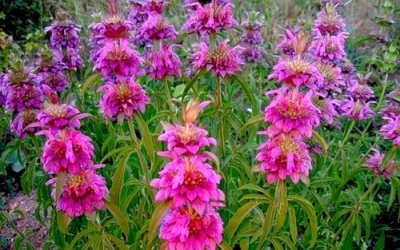

This is an annual, also called a citrus monard. Reaches 15-95 cm in height, the leaves are oblong, lanceolate. It blooms with small lilac buds (see photo). From the parts of the plant, a precious essential oil is extracted, similar in composition and aroma to the oils of lemon balm, bergamot and mint.The leaves can be used as a condiment.
Double
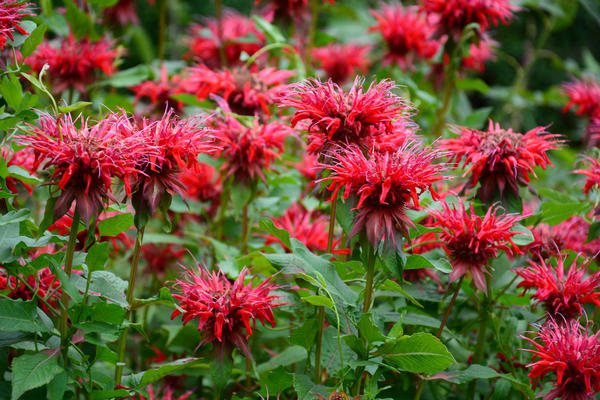

This is a perennial monarda, growing up to 80 cm. The bush grows strongly over time, taking up a lot of space in adulthood. The flowers are purple or lilac, the leaves are large, lanceolate, and slightly edged.
Fisty
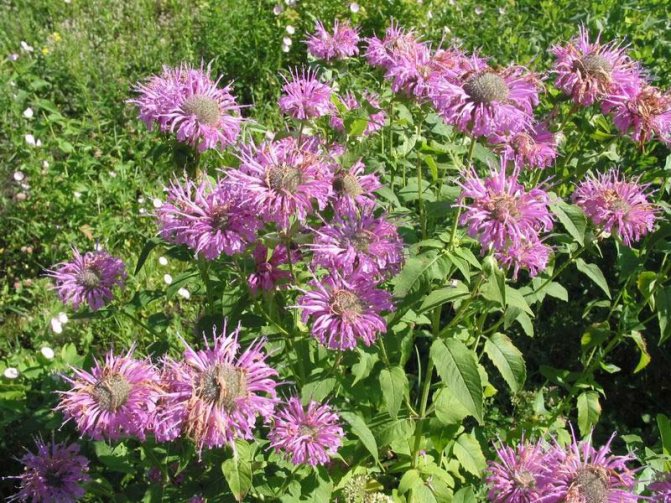

This monard is also called tubular. Grows naturally in the forests of North America. In Europe, it is grown as a cultivated plant. The fistus monarda shrub has many shoots, reaches a height of 65-120 cm. The leaves have a simple structure, the flowers are lilac, rather small.
Point
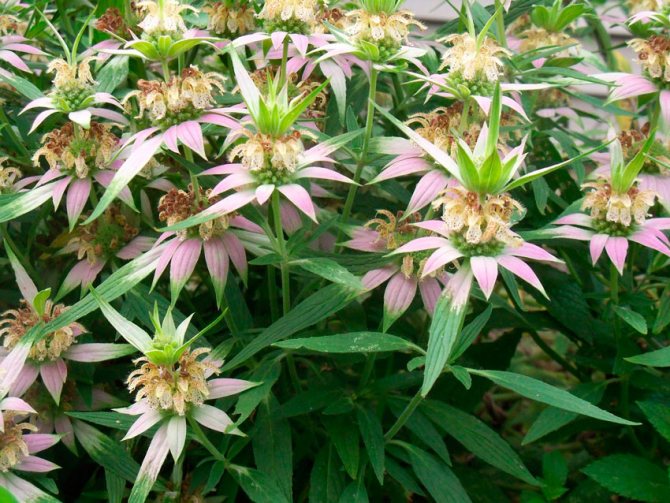

Although this species is rare in our gardens, it boasts an unusual appearance. The fact is that the leaves of the dotted monarda have an interesting spicy-salmon shade. The second name of the plant is horse mint. The bush reaches a height of 80 cm.
Application
In the garden, monarda bushes look great on flower beds, they are also used to decorate squares and parks, urban recreation areas. Due to its unpretentiousness and ability to develop normally in any conditions, monarda is an ideal plant for landscaping a city. The plant can decorate rabatki, lawns, looks good near fences and hedges, allowing you to hide not too attractive buildings.
Monarda looks good as a single shrub. But it is especially advantageous when combined with coniferous shrubs, small deciduous plants, flowers and decorative cereals. When planting, it should be borne in mind that the monard grows quite tall, so it is better to use it in the background in a flower bed. Otherwise, the shrub will shade undersized neighbors.
If we talk about flowers, bells, daisies, rudbeckia, perennial phlox will look great next to the monard.
How to create conditions for planting monarda in the ground?
Monarda, planting and care in the open field for which requires a lot of effort, will be able to fully bloom in a short time only if the gardener creates all the conditions necessary for it. This is not difficult to do, but you still need to be very careful.
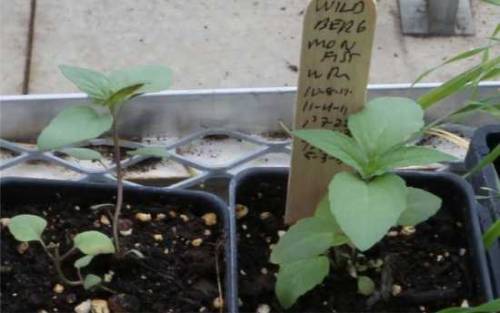

Monarda seedlings ready for planting
For a monarda, you should choose a plot of land that is well heated by the sun, which is reliably protected from the wind at any time of the year. However, the monard will be able to adapt in semi-shaded places. She needs a light soil, generously enriched with lime and minerals. The soil should be moderately moist, but not waterlogged, as this can negatively affect the growth rate of the plant.
Spring is the perfect time to plant and care for a monarda. But a place in the garden for her should be chosen in advance, in the fall. The selected area is cleared of all weeds, treated to protect against insect pests, and enriched with manure (at least 2 kilograms per square meter).
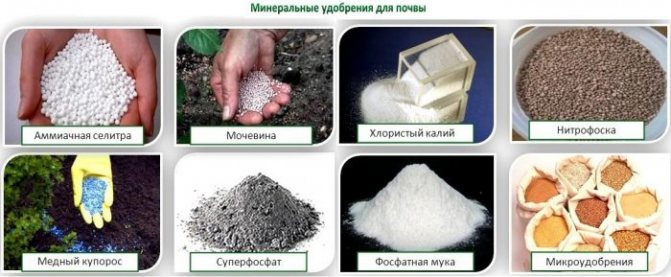

Among the minerals, especially useful for monarda, potassium salt, superphosphate and any lime are distinguished. Also, nitrogen fertilizers will not be superfluous, but they are added directly on the eve of planting.
Landing monarda
Leaving and planting monarda in open ground should take place after a sufficient number of leaves have formed on the seedlings. This will happen no earlier than 2-3 months after the start of planting work.
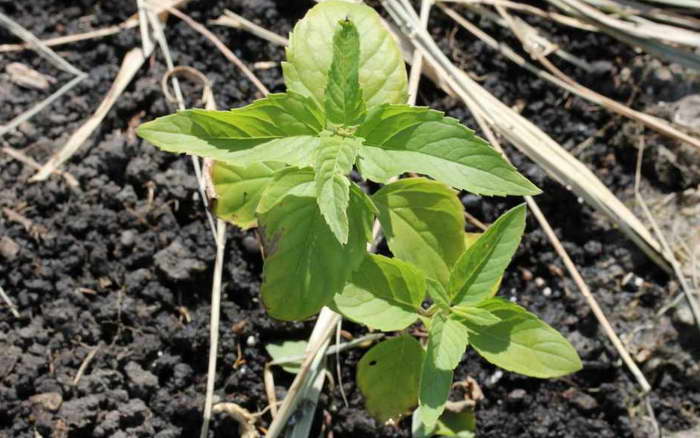

Monarda bushes should be at a considerable distance from each other (about 60 cm). A newly planted plant needs abundant watering.
Monarda, transferred to open ground, is not at all afraid of Russian frosts. She can easily survive even freezing temperatures.
If the gardener used seed planting, he will see the first flowering only in the next season. But if he resorted to the help of seedlings, the monarda can bloom already this year, but for this you need to take care of it especially anxiously.
Monarda: combination with other plants
Monarda bushes look great on flower beds in gardens and squares.Tall crops adorn the green spaces of cities. An unpretentious flower requires minimal maintenance. Monarda forms interesting combinations with decorative deciduous plants, conifers and annuals. It is necessary to watch out when planting so that a tall, oversized plant does not shade undersized neighbors.
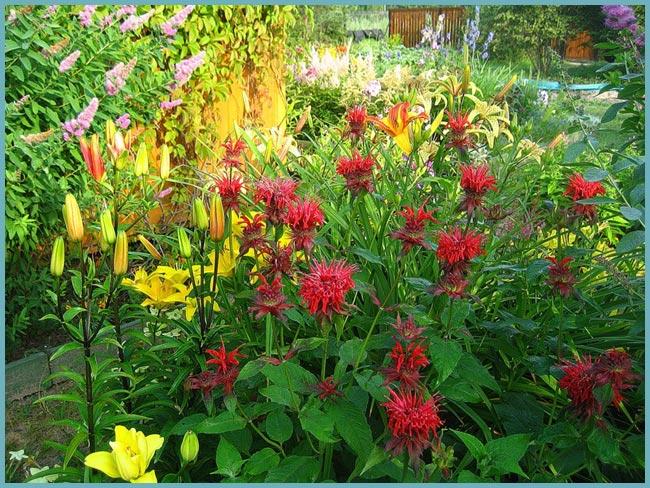

Monarda combined with lilies
Individual group plantings of monarda are very decorative, especially when choosing harmonious colors of petals. Choosing a combination of contrasting tones or soft tone transitions - it all depends on the architect's ideas when decorating the territories of park zones.
Monarda care rules
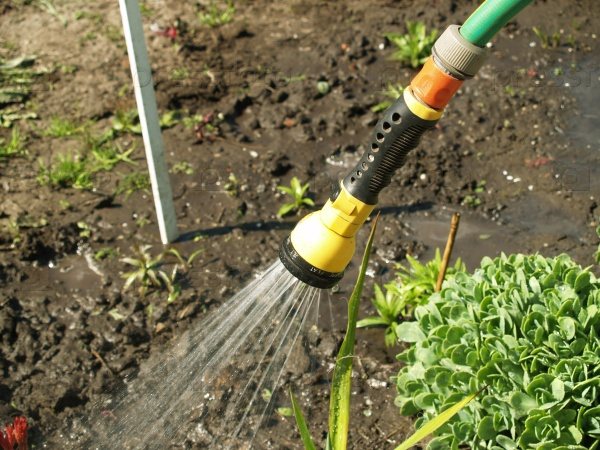

In spring and autumn, the monarda does not need large amounts of water, but in the summer it should be watered as often as possible. In the hottest weeks, the monarda should be watered daily.
If the gardener for some reason neglects regular watering, the monard can get sick with powdery mildew. In this case, the care and planting of the monarda can be in vain, since the plant may not cope with this disease.
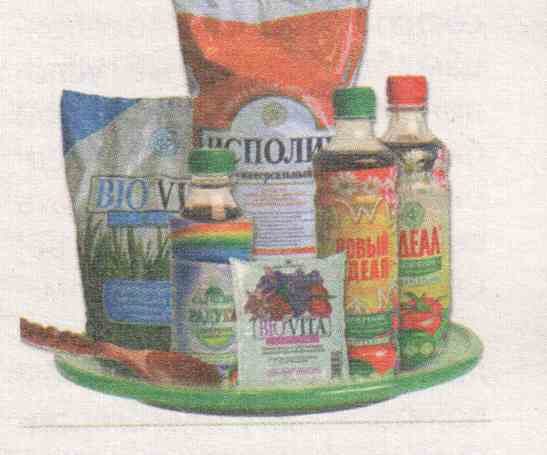

Fertilizers for the garden
Monarda, like any flowering crop, needs active feeding. Agricola and Kemira are best suited for this purpose. You need to process the plant with them at least twice a month, until the growing season comes to an end. Fundazol will help protect bushes from various pests. Bordeaux mixture can also contribute to a successful fight against insects.
Top dressing and fertilizers
Top dressing is applied during the growing season and during the flowering culture. Complex mineral fertilizers are used in spring. For each square meter, 40-45 g of top dressing is consumed.
At the end of summer and during the flowering period, the monarda needs fertilizing containing phosphorus and potassium. Dry granules are embedded in the soil. Top dressing gradually dissolves and, when irrigated, goes to the root system. Fertilizers stimulate flowering.
During the growing season and flowering time, the bushes need to be sprayed with water with mineral dressings.
Advice! So that during the hot period the plant does not experience stress, the leaf plates are treated with Epin's solution.
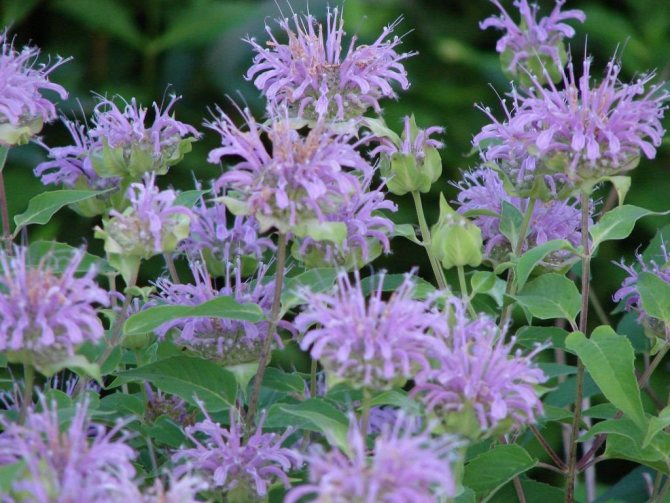

Monarda fistus
Reproduction of monarda by dividing the bush
For successful planting of monarda and caring for it, the plant must be propagated. The easiest way to do this is by dividing the bush. In addition, only this method allows you to preserve the characteristics of a particular variety and avoid the appearance of beautiful, but much less valued hybrids.


Dividing a bush cannot be done until it is at least 3 years old. When the required period has passed, this procedure can be carried out twice a year: in the middle of spring, taking advantage of the fact that at this time the soil is properly warmed up, and at the very beginning of autumn. In order for everything to work out, you need to carefully extract the roots of the monarda from the earth and separate them.
New bushes return to the ground at the same depth. It won't take long for them to grow. After 2 years, the resulting bushes will grow strongly, and you will have to use the method of dividing the bush again.
Plant propagation
Reproduction of a perennial is allowed in two ways: vegetative and seed. When vegetative reproduction monarda is made by dividing the bush and segments of rhizomes. The bush is dug up, cut into several parts with the division of the root system. Sections are powdered with ash, sprinkled with charcoal. Delenki sit in pits prepared in advance with fertile soil. Reproduction of monarda by dividing the bush allows you to quickly get young plants that retain all the characteristics of the variety. Young plants bloom in a year.
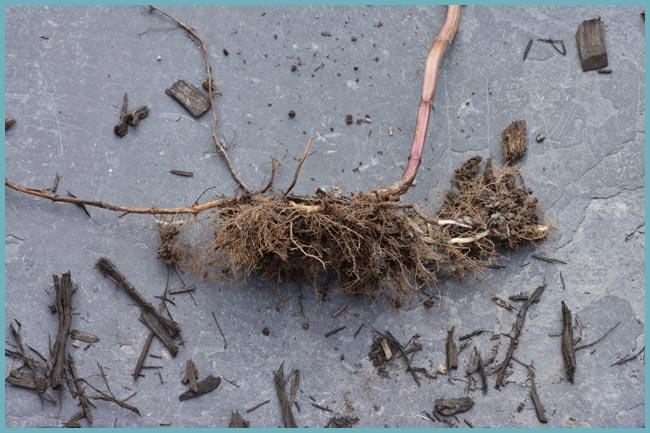

Monarda root
Reproduction of flower culture seeds shown if pollination of plants was undertaken to obtain new hybrids. Seeds are sown in special containers, in the phase of 4 leaves, a pick is made. The germination temperature is + 20 ° C.The slow growth of seedlings at first will more than pay off when the plants gain strength. Young plants planted in a permanent place need to be weeded and watered periodically. Seed propagation allows you to get new varieties with interesting petal colors. The disadvantage of this method is that the monard from seeds does not bloom in the 2nd year of development.
Propagation of monarda by cuttings
Another method of breeding monarda is associated with the use of cuttings. To implement it, the gardener will need at least 7 cuttings 0.1 m long. These should be shoots from a large bush that did not have time to reach the flowering stage.
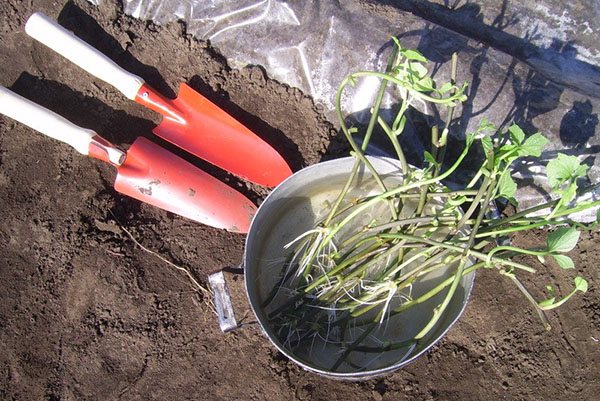

Planting rooted cuttings
All leaves growing from the bottom of the handle are cut off. The upper leaves are not completely removed, but pruned.
For the cuttings, you need to prepare a spacious box in advance, where they will be planted. The container must be filled with a mineral-rich substrate. However, you can do without this - the cuttings can take root in a container filled with water.
No later than 3 weeks later, the cuttings develop a developed root system. After that, they can already be transplanted into open ground, not doubting that they will be able to survive in it.
Double monarda and fistous monarda
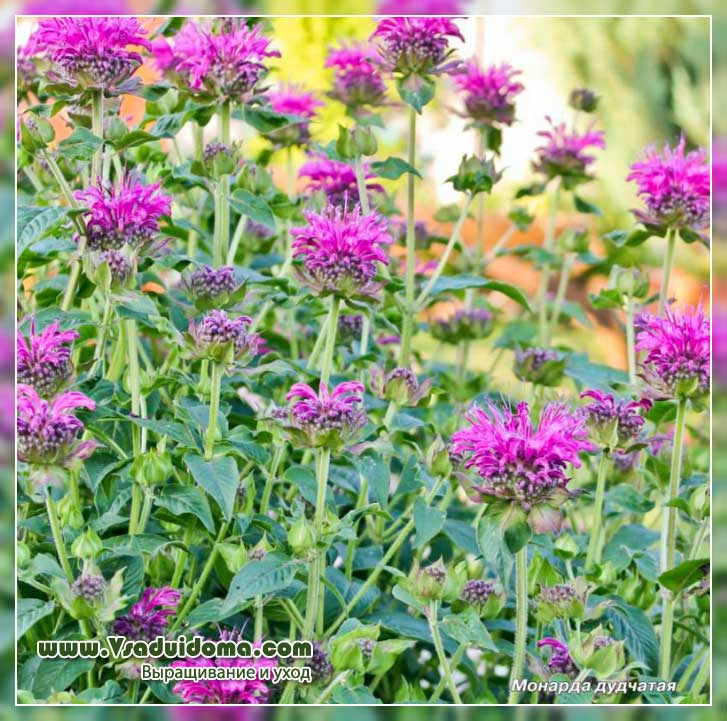

Do you like bergamot tea? Plant a monarda on your site! Essential oils from plants are so similar that they can be used interchangeably.
APPEARANCE
Rhizome plant with straight or branched stems up to 150 cm high
LEAVES
Simple, oblong-lanceolate, serrated
FLOWERS
Small, fragrant, white, red, purple, yellowish or speckled, collected in dense racemose or capitate inflorescences 6-7 cm in diameter
FETUS
Nut
Today we will talk about two perennial monards at once - this is a double monard (height - up to 90 cm, flowers are scarlet, crimson, bloom from July to the end of summer) and a fist-shaped or tubular monard (height - 65-120 cm, flowers are small, lilac, bloom in June-July from the second or third year of life).
Optimal location
Monarda are photophilous, grow well and bloom in sunny places (although they can withstand shading) with light, drained, calcareous soils. On the poor, they are fed 2 times per season with full mineral fertilizer - 2-3 weeks after planting plants in open ground and after flowering.
Seedlings are planted in open ground in early June. The optimal distance between rows is 70 cm, between plants - 30 cm.
TIP: In hot dry summers, be sure to water the monarda, but do it carefully: try not to get water on the plants themselves.
Effectively!
Both monards go well with phlox, cosmea, rudbeckia, goldenrod. They are captivating during the flowering period, which makes them suitable for group planting in the background or among tall plants in a spicy bed. Monards can also be planted in containers.
As a result of pruning (2 times - at a height of 20 cm from the soil surface to the branching zone of flowering shoots), beautiful flower borders or whole clumps are obtained. Monarda is good at cutting - it stands in water for up to 20 days.
For gourmets
You can use young leaves of both monards for food, adding them to salads, soups, sauces. Monarda is an excellent flavoring agent for tea, strong liqueurs (like vermouth), apple and pear jam. As a spice, the plant is harmoniously combined with parsley, celery, anise, cloves, cinnamon, lemon balm.
For medicinal purposes
Monarda greens have bactericidal properties, stimulate appetite, and improve digestion. The juice of fresh leaves can be used to lubricate fresh and non-healing wounds. Tea with monarda is useful to drink with bronchitis, flatulence. Bags with dried monarda are placed under the pillow for insomnia.
How to make aromatic tea? Raw materials are harvested during the period of mass flowering. Inflorescences with shoots are cut off at a height of 20-30 cm from the soil surface. Dried at a temperature not higher than +30 degrees, in a ventilated room or under a canopy.Dry monarda is passed through a meat grinder and stored in closed glass jars. For brewing 2 tsp. raw materials are poured into 1 tbsp. boiling water and insist for 20-30 minutes.
BEANS WITH MONARD
300 g beans, 1 tsp. crushed dry leaves of monarda, 2 tsp. chopped fresh leaves of monarda, 2 tbsp. tomato paste, 2 tablespoons vegetable oil, 1 onion, 1 clove of garlic, 1 tbsp. flour, salt, pepper to taste.
Boil the beans soaked overnight until tender, drain the water. Fry chopped onions until golden brown, add flour and tomato paste diluted with water. Pour all this into the beans, add the monarda, garlic, salt, pepper and boil until thickened.
M.Kireeva, Bogotol
Diseases and pests
Monarda is a plant that rarely suffers from diseases and insect pests. The bushes have a strong innate immunity, which is explained by the fact that they contain essential oils.
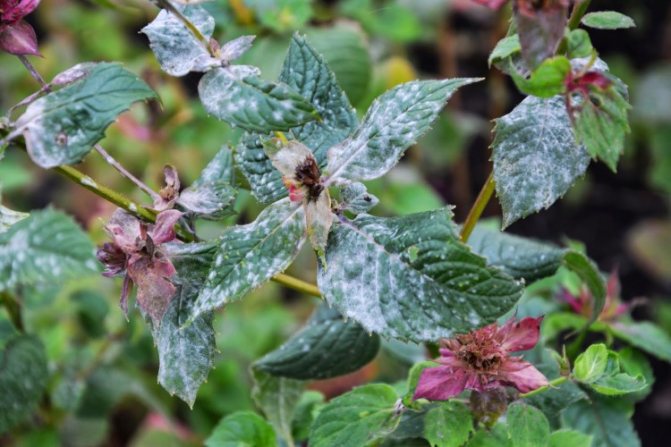

Powdery mildew on the leaves of monrada
However, during the hotter months of the year, the monarda can get sick with powdery mildew. The bushes are hard to bear this disease and may even die from it. To protect your pet from powdery mildew, the gardener should regularly water the plant and mulch the soil.
Of the harmful insects, the weevil can harm the monarda, but it is not difficult to drive it away. In general, planting a monarda and caring for it will not take a lot of energy from the gardener if he can do all the necessary procedures on time.
Growing monarda from seeds
Like many other flower crops, the monarda has certain growing characteristics. In most cases, it is cultivated from seeds, both by seedlings and by direct sowing into the ground.
Let us consider in more detail the features of growing bergamot from seeds, depending on the capabilities of the gardener and climatic conditions.
Sowing
In warm southern climates, bergamot seeds can be sown directly into the soil. For this, a relatively warm and sunny February day is chosen. Sowing seeds in the ground in winter will not at all affect the cultivation, since the planting material has a high germination capacity, and such an early sowing will allow the seeds to undergo natural stratification (Figure 2).
The first shoots appear in April, but they must be thinned out, leaving only the strongest specimens in the garden.


Figure 2. Growing bergamot from seeds
It also happens that the snow cover does not allow early sowing. In this case, the selected area must be cleared of snow and covered with a black film for several days so that the soil warms up slightly. After that, the soil must be thoroughly loosened by adding a little sand to the soil. Next, the selected seeds must be mixed with clean sand (proportion 1: 4) and spread over the soil surface. From above, the bed is re-sprinkled with sand, but it is important to ensure that the seeds were in the soil at a depth of no more than 2.5 cm.
If you do not have the opportunity to sow seeds in winter, you can carry out the procedure in the fall, immediately after collecting the planting material. The sowing algorithm remains the same, but the difference is that in the spring the seedlings must be thinned out.
Seedling
In temperate climates, it is much more profitable to use the seedling method of growing, which is considered one of the most popular, since it allows you to get a large amount of high-quality planting material.
For growing bergamot seedlings, seeds are sown in separate pots or boxes in January. It is better to use soil mixes for vegetable crops, which include all the necessary nutrients for monarda. Sowing is carried out in the same way as directly into the ground. The only difference is that the containers must be covered with film or glass, and transferred to a warm room or greenhouse with a temperature of +20 degrees. In such conditions, the first shoots will appear in three weeks.After another month, the seedlings can be dived into separate pots, placing one plant at a time in an area of 3-4 square centimeters.
Collecting Monarda Seeds
From year to year, monarda seeds ripen at about the same time. This happens at the end of August or the first week of September. Since the seeds can spill out and die, during this period you need to carefully monitor the bushes.
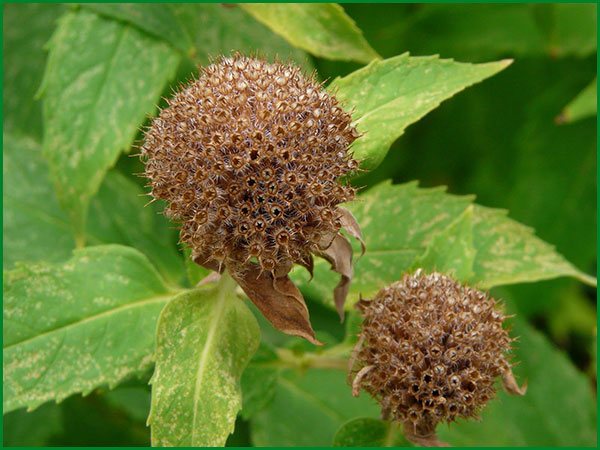

Ripe Monarda Seeds
Monarda, planting and care in the open field, which was carried out all season, will inevitably give a sufficient number of dried testes. In order for them to finally ripen, they are cut off and left to dry in a cool shady area of the garden.
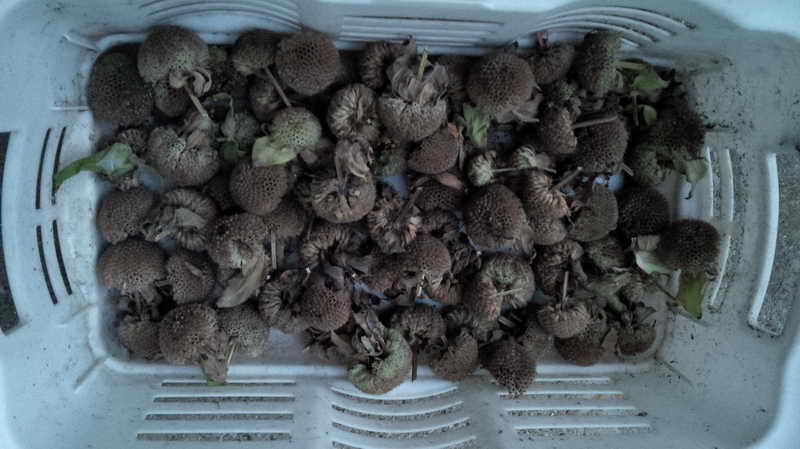

Collected Monarda Seeds
The resulting seeds can be immediately sent to the ground. But most often they are stored in order to be used in the next season. As noted above, monarda seeds have a high germination capacity and do not lose it for 3 years.
The monarda obtained as a result of planting seeds of hybrids will not be capable of performing the parental function. The seeds obtained from it will never give life to a new plant.
You can also leave ripe seeds. In this case, in the winter months birds will be able to eat them, and you will act as a breadwinner for a dozen feathered guests.
Flowering period and care
In order for the monarda bush to please not only with colorful greenery, but also with abundant flowering, the bush needs additional feeding. The plant blooms in the second half of summer. In total, the flowering period takes about 50 days. At this time, feeding is not worth it. You can only carry out preventive measures to relieve stress from the sultry heat if the summer is too hot. Excess fertilization has the opposite effect, and the flowering becomes scarce.
Otherwise, care during the flowering period is not much different from the usual. You need to water the plant regularly, it is better to do it daily and in small portions of water. Pruning the plant is not recommended, you can only spread a layer of mulch around the bush to retain moisture for a longer period.
After flowering, fruits with seeds are formed. They can be harvested and sown directly into open soil. You can even grow seedlings from them for the next planting season. Seed germination lasts for 3 years.
Preparing monarda for the winter period


The annual monarda is not able to cope with the severe Russian frosts, so for the winter the flower beds are cleared of it. But the perennial monarda is able to withstand even severe cold (up to -25ºC).
If even more severe frosts are promised in your region in winter, you can help the monarda by covering it with cellophane, straw or hay for the winter. Since this coating can scatter all over the area due to the wind, it is worth pressing it to the ground with any heavy load.
As soon as spring comes to replace winter, and subzero temperatures are in the past, the protective coating is rapidly removed from the ground. This will help the plant to quickly move away from hibernation and prepare for the new season.
Types of monarda with photo
The species diversity of Monarda is not too great; according to various sources, the genus includes 16 or 20 varieties with numerous varieties and hybrids.
Double monard
This is the most common variety cultivated in Europe since 1656. The average height of the bush is 0.8 m. The color options are very diverse, including not only monophonic, but also speckled varieties. In the basic version, the flowers are bright red, with slightly darker bracts. Forms a capitate-type inflorescence up to 6 cm in diameter, small flowers. This particular variety is often called golden lemon balm or bee bergamot.
Tubular monard (fist)
A taller variety, the stems of which often grow up to 120 cm. The buds are small, collected in a spherical inflorescence. There can be up to 9 of them on one flower.
There is also a dwarf form of a tubular monarda, the height of which does not exceed 35 cm.Its flowers and leaves are very fragrant, with a citrus scent. The base paint is pink or lilac. Fist monarda is widely used in cooking for flavoring meat dishes, tea, and also for flavoring in the process of vermouth production. It has medicinal properties aimed at improving digestion, helping with coughs and lack of appetite.
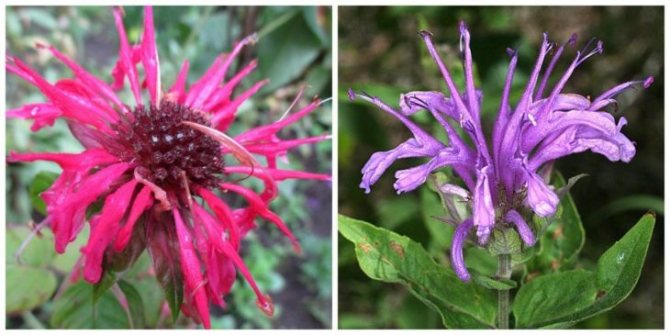

Monarda lemon
It also has a decorative appearance, however, it is most valued for its particularly strong smell from all aerial parts of the plant. Its aroma combines the scents of citrus peel and mint leaves.
Monarda messy
In gardening culture, it is found less often than others, it blooms in a lavender lilac tone, better known under the name "oriental bee balsam".
Popular decorative varieties
- "Mahogany" is an early flowering variety with dark red inflorescences, the petals of which are twisted at the ends. It blooms for a long time, until the very frost.
- "Adam" is a very light-loving varietal variety that blooms in a bright scarlet color. Does not tolerate even light shading.
- Croftway punk "is one of the most spectacular blooming varieties with charming pink-lilac buds.
- "Snow white" - gives flowers of a snow-white color, looks especially charming in mono-plantings.
- "Panorama" - has a rich palette of colors and an attractively exotic shaggy shape of flowers.
Tea brewed with the addition of monarda herb is given to patients with fractures and other injuries of the musculoskeletal system. You can use both dried and fresh raw materials.
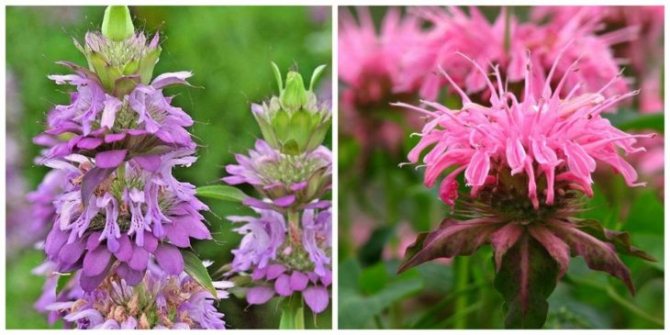

Monarda varieties
Leaving and planting monarda in open ground would not be such an interesting process if this plant did not have many varieties. Below we will only talk about the most popular of them.
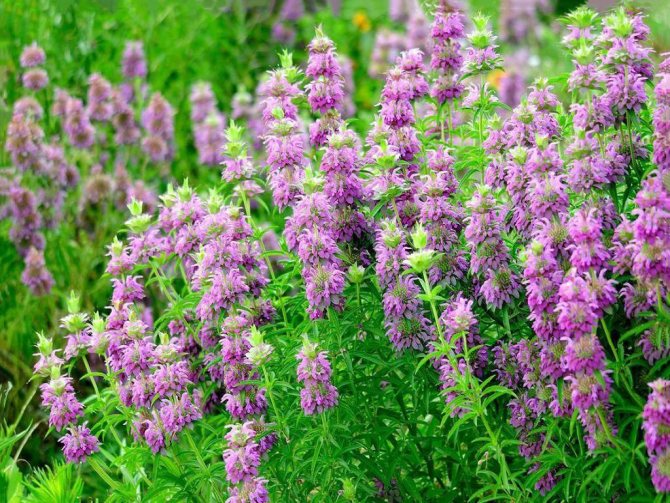

Citrus Monarda
It is customary to refer to annual types of monarda as citrus, hybrid and spot varieties. Citrus Monarda is the tallest annual in the world. Her height can reach 1 meter.
The leaves of this plant contain a large amount of essential oils, for which lemon monarda is often compared with basil or mint. It is this variety that is used as a spice, adding the plant to tea to give it a unique taste.
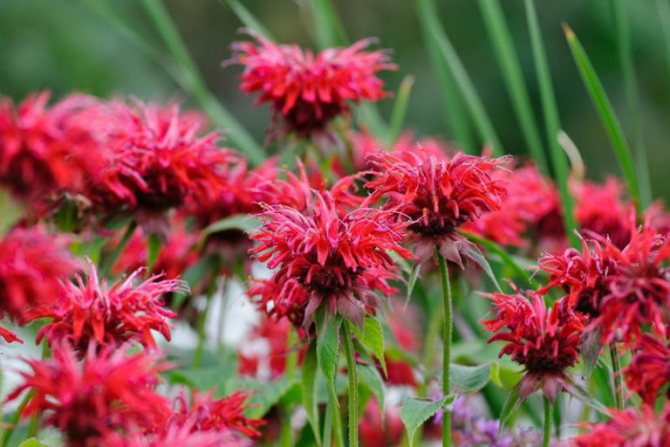

Hybrid monard
Hybrid monard was born in Holland, where local breeders spent several years breeding a new plant. Lemon monarda was also used in its creation, so that the leaves of the hybrid variety smell like the leaves of the variety described above. The care and planting of a hybrid variety monarda is a process that is fundamentally different from the breeding of other varieties.
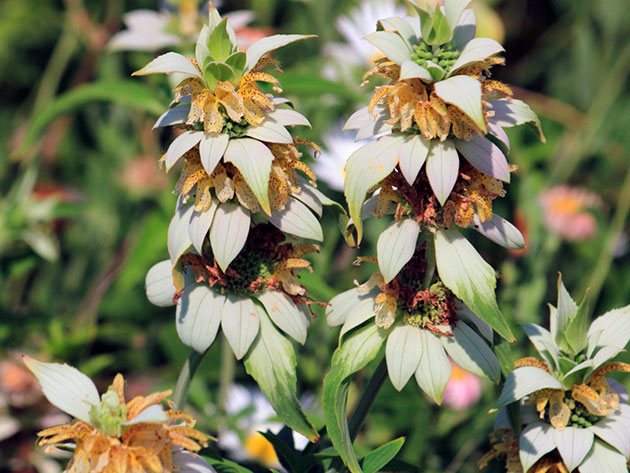

Point monard
Point monard known in wide circles under a different name. It is commonly referred to by botanists as horsemint. It is not difficult to distinguish this variety from the rest because of the large orange leaves completely surrounding the inflorescence.
The types of perennial monarda include double, fist and hybrid varieties. Botanists learned about the double monard in the middle of the 17th century and first described it in their writings.
This variety has a considerable height - about 80 cm. The leaves are oval, pointed, practically odorless, but very beautiful, which makes the double monarda very popular among gardeners. The flowers have a pronounced purple hue, which becomes even more intense towards the end of flowering.
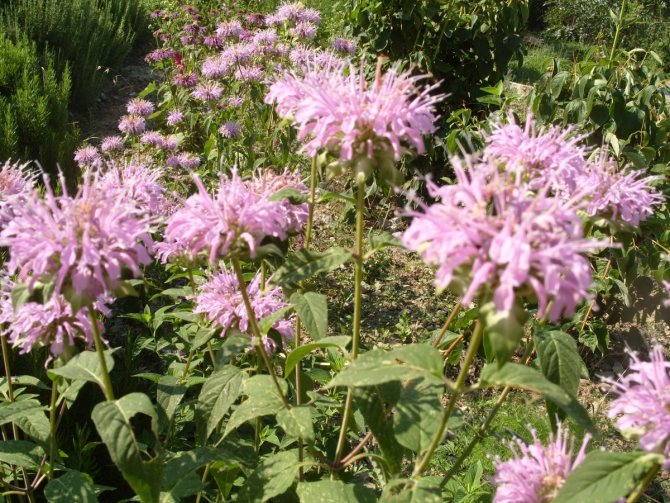

Wild bergamot
The fisty monarda is also known as the wild bergamot. Her homeland is North America, where she grows freely without anthropogenic impact. The fisty monarda is one of the tallest varieties and reaches 120 cm.
Soft fluffy hairs grow on the surface of the leaves. The flowers are pale lilac in color. Russia became the birthplace of the dwarf fist-shaped monarda. The care and planting of this variety monarda require special attention from the gardener.
The hybrid perennial monard is famous for its color variety.Its flowers can be white, red, purple, purple, and this is just part of a long list of naturally occurring colors and shades.
Useful properties of the monarda plant
In addition to beauty, the monard has useful properties, which is its important advantage. Experienced botanists say that the monarda is closely related to mint.
Important! Hybrid varieties of this plant cannot be used as a seasoning.
The plant has a persistent and pleasant odor, which makes it suitable for cooking. Also, this flower is used to make delicious tea and wine. In ancient times, the monarda flower was still grown and used to reduce the temperature or relieve pain. This shrub helped to relieve sore throat and lung diseases.
The planted monard can become the central decoration of even the most inconspicuous area. In addition to the decorative properties, gardeners obtain fragrant and healthy leaves that can be used in making delicious tea.
Healing properties
Leaving and planting monarda in open ground can also have practical benefits, since the plant has unique healing properties. Monarda contains not only essential oil, but also a whole complex of vitamins, among which vitamins of group C occupy a special place.
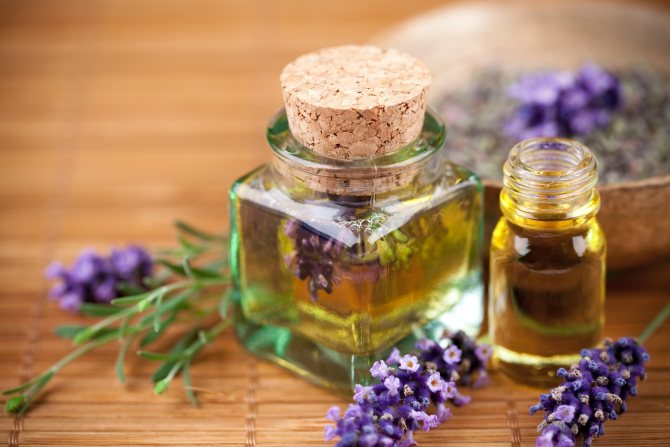

Essential oil
Essential oil is an unsurpassed antidepressant. It can also be used as an antianemic property, and even helps a woman with the implementation of reproductive function. Consuming essential oil on a regular basis minimizes the possibility of suffering from radiation sickness or the formation of sclerotic plaques.
Monarda is actively used as a cosmetic product. It helps in the treatment of oily skin in people over 45.
Varieties of culture
There are many varieties of monarda. Usually, experts divide them depending on the duration of the life period, namely: annual, perennial.
Annuals
Monarda boasts a variety of annual varieties, some of which are.
Citrus monarda or lemon
An annual with branched straight shoots capable of growing 150 cm in height. Monarda has lanceolate leaf blades with a serrated edge. The two-lipped flowers are painted in different colors: purple, light yellow, white, red. The flower is prized for its lemon scent, thanks to which its inflorescences are added to tea and used as a spice. The fruit is a nut.
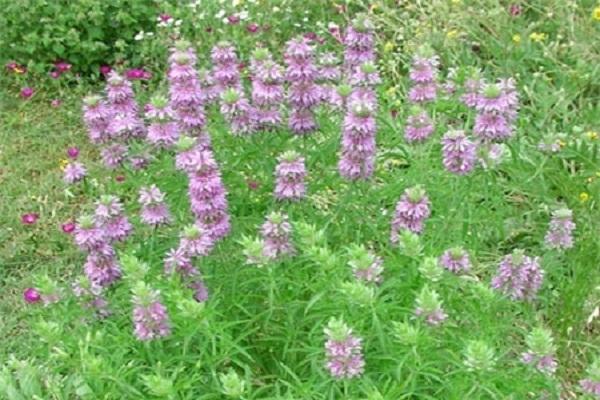

Hybrid monard Lambada
This variety is considered an excellent honey plant and is actively used as an ornamental crop. The hybrid monard is bred artificially, therefore it does not occur in the wild. It was first received by breeders in the Netherlands. Its main feature is a strong lemon tart aroma of perennial leaves and stems. Has a similarity in appearance to the lemon monarda.
Point monard
The second name of the plant is horse mint. The height of the monard reaches a maximum of 80 cm. It is actively cultivated not only because of the exquisite fragrant flowers that form elongated thorns at the end of the stem, but also because of the bright salmon-colored leaves surrounding the inflorescences. It happens that such leaves overshadow the buds with their impressive size. The flowering period is about 50 days.
Perennial
The most common perennial types of monarda include the following.
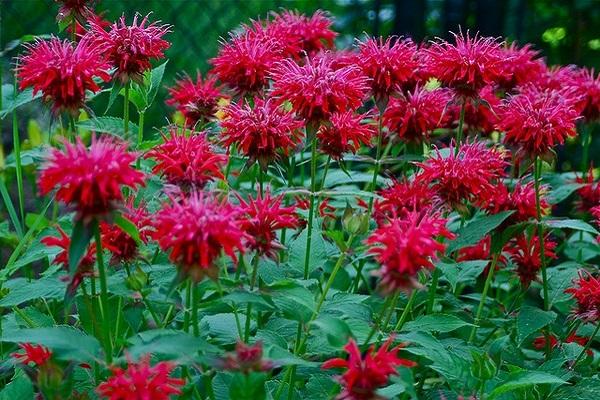

Double monarda Monarda didyma
A perennial plant that grows up to 1 meter. Monarda grows in the meadows of great lakes, has a powerful root system, a strong stem and opposite leaves located on it. The length of the leaf is 12 cm, the edge is pointed above, has a serrated edging, is colored green, and the stipules are distinguished by a reddish-red hue. The monarda blooms in lilac-purple color, forming a round inflorescence about 5 cm in diameter.
Fist or tubular Monarda fistulosa wild bergamot
The main purpose of growing tubular monarda is to make spices. The bush itself of impressive size reaches 1.2 meters in height, has a fibrous root system. The tops are decorated for a long time with capitate inflorescences up to 5 cm in diameter. The petals of the bud are white or burgundy.
Hybrid monarda x hybrida
Perennial herb, sectioned by combining two common types of monarda Double and Dudchaty. Unpretentious culture to care for, does not require special growing conditions. The main varieties of monarda hybrid include: Scarlett, Mahogany, Elsiz Lavender, Lambada. Each of the varieties differs in color and height of the bush.
